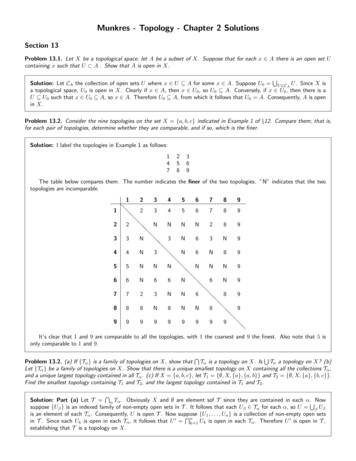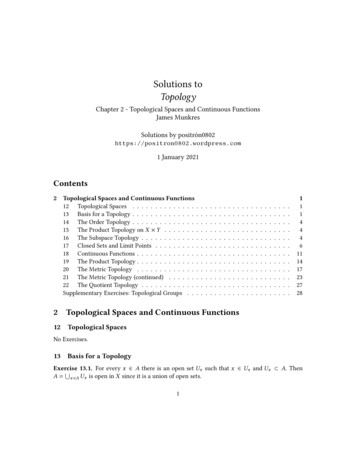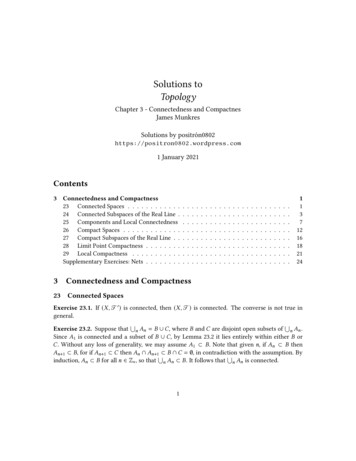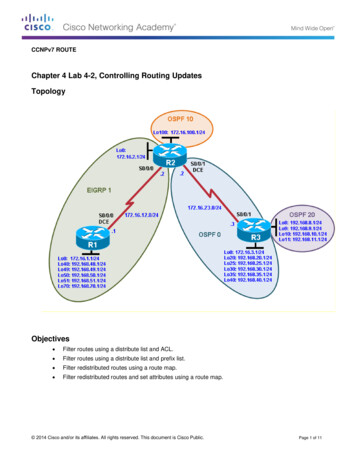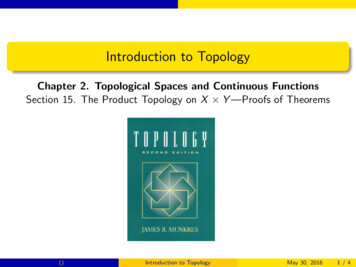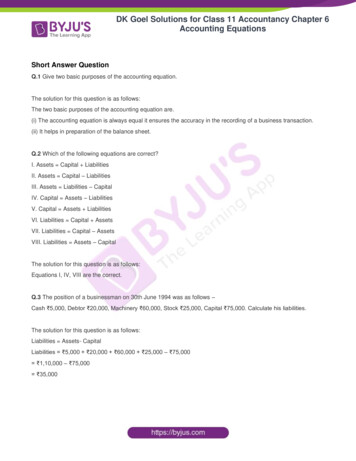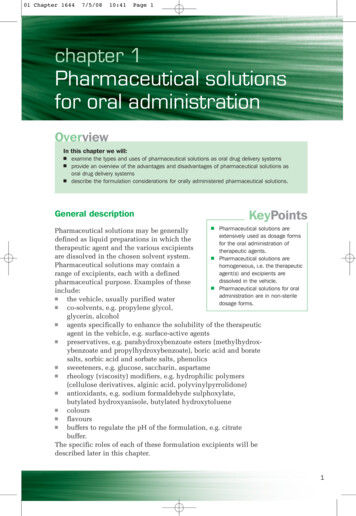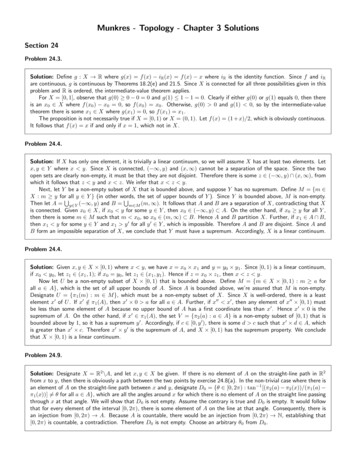
Transcription
Munkres - Topology - Chapter 3 SolutionsSection 24Problem 24.3.Solution: Define g : X R where g(x) f (x) iR (x) f (x) x where iR is the identity function. Since f and iRare continuous, g is continuous by Theorems 18.2(e) and 21.5. Since X is connected for all three possibilities given in thisproblem and R is ordered, the intermediate-value theorem applies.For X [0, 1], observe that g(0) 0 0 0 and g(1) 1 1 0. Clearly if either g(0) or g(1) equals 0, then thereis an x0 X where f (x0 ) x0 0, so f (x0 ) x0 . Otherwise, g(0) 0 and g(1) 0, so by the intermediate-valuetheorem there is some x1 X where g(x1 ) 0, so f (x1 ) x1 .The proposition is not necessarily true if X [0, 1) or X (0, 1). Let f (x) (1 x)/2, which is obviously continuous.It follows that f (x) x if and only if x 1, which not in X.Problem 24.4.Solution: If X has only one element, it is trivially a linear continuum, so we will assume X has at least two elements. Letx, y Y where x y. Since X is connected, ( , y) and (x, ) cannot be a separation of the space. Since the twoopen sets are clearly non-empty, it must be that they are not disjoint. Therefore there is some z ( , y) (x, ), fromwhich it follows that z y and x z. We infer that x z y.Next, let Y be a non-empty subset of X that is bounded above, and suppose Y has no supremum. Define M {m X : m y forSall y Y } (in other words,the set of upper bounds of Y ). Since Y is bounded above, M is non-empty.SThen let A y Y ( , y) and B m M (m, ). It follows that A and B are a separation of X, contradicting that Xis connected. Given x0 X, if x0 y for some y Y , then x0 ( , y) A. On the other hand, if x0 y for all Y ,then there is some m M such that m x0 , so x0 (m, ) B. Hence A and B partition X. Further, if x1 A B,then x1 y for some y Y and x1 y 0 for all y 0 Y , which is impossible. Therefore A and B are disjoint. Since A andB form an impossible separation of X, we conclude that Y must have a supremum. Accordingly, X is a linear continuum.Problem 24.4.Solution: Given x, y X [0, 1) where x y, we have x x0 x1 and y y0 y1 . Since [0, 1) is a linear continuum,if x0 y0 , let z1 (x1 , 1); if x0 y0 , let z1 (x1 , y1 ). Hence if z x0 z1 , then x z y.Now let U be a non-empty subset of X [0, 1) that is bounded above. Define M {m X [0, 1) : m a forall a A}, which is the set of all upper bounds of A. Since A is bounded above, we’re assured that M is non-empty.Designate U {π1 (m) : m M }, which must be a non-empty subset of X. Since X is well-ordered, there is a leastelement x0 of U . If x0 / π1 (A), then x0 0 a for all a A. Further, if x00 x0 , then any element of x00 [0, 1) mustbe less than some element of A because no upper bound of A has a first coordinate less than x0 . Hence x0 0 is thesupremum of A. On the other hand, if x0 π1 (A), the set V {π2 (a) : a A} is a non-empty subset of [0, 1) that isbounded above by 1, so it has a supremum y 0 . Accordingly, if c [0, y 0 ), there is some d c such that x0 d A, whichis greater than x0 c. Therefore x0 y 0 is the supremum of A, and X [0, 1) has the supremum property. We concludethat X [0, 1) is a linear continuum.Problem 24.9.Solution: Designate X R2 \A, and let x, y X be given. If there is no element of A on the straight-line path in R2from x to y, then there is obviously a path between the two points by exercise 24.8(a). In the non-trivial case where there isan element of A on the straight-line path between x and y, designate D0 {θ [0, 2π) : tan 1 [(π2 (a) π2 (x))/(π1 (a) π1 (x))] 6 θ for all a A}, which are all the angles around x for which there is no element of A on the straight line passingthrough x at that angle. We will show that D0 is not empty. Assume the contrary is true and D0 is empty. It would followthat for every element of the interval [0, 2π), there is some element of A on the line at that angle. Consequently, there isan injection from [0, 2π) A. Because A is countable, there would be an injection from [0, 2π) N, establishing that[0, 2π) is countable, a contradiction. Therefore D0 is not empty. Choose an arbitrary θ0 from D0 .
Next, designate D1 {θ [0, 2π) : tan 1 [(π2 (a) π2 (y))/(π1 (a) π1 (y))] 6 θ for all a A}, which are all the anglesaround y for which there is no element of A on the straight line passing through y at that angle. By the same argument,D1 is not empty. Choose an arbitrary θ1 from D1 .Now let z X be the point at which the two lines from x and y at the angles θ0 and θ1 , respectively, intersect.There is no element of A on the line segments from x to z and z to y. Therefore we can construct the continuous mapsk0 : [0, 1] X and k1 : [1, 2] X where k0 (0) x, k0 (1) k1 (1) z, and k1 (2) y. By the pasting lemma, wecan generate the continuous map k : [0, 2] X from k0 and k1 that forms a path from x and to z. Accordingly, X ispath-connected.Problem 24.10.Solution: Suppose U is an open connected subspace of R2 . Let x0 U be given and V be the set of points in U to whichthere is a path from x0 in U . Since U is open in R2 , there is some non-empty basis element B0 U of R2 that containsx0 . By exercise 24.8(a), there is a path from x0 to every point in B0 , so B0 is contained in V . Hence V is non-empty.If v V , there is a basis element B1 containing v that is contained in U . Since B1 is a subset of R2 , it is path-connected.Since there is a path from x0 to v and a path from v to any point v 0 B1 , there is a path from x0 to v 0 . Consequently,B1 is contained in V . Because this is true for every element of V , it follows that V is the union of basis elements of U , soV is open in U .Now let W U \V . If w W , there is a basis element B2 containing w that is contained in U . Since B2 is pathconnected, there cannot be any path from x0 to any element w0 W ; otherwise, there would be a path from x0 to w0 ,then w0 to w, contradicting that there is no path from x0 to w. Therefore B2 is contained in W , from which it followsthat B2 is the union of basis elements of U . Hence W is open in U .Since V U \W , the set V is closed in U . Since V is both open and closed in the connected subspace U , it eitherequals U or is empty. We know V is non-empty, so V U . We conclude that U is path-connected.Section 25Problem 25.1.Solution: Suppose A is a connected subspace of R containing a given pair of points x and y where x y. It followsthat A (( , y) A) ([y, ) A), where the two rays are open in A and therefore form a separation of the space.Accordingly, for any two distinct points in A there is no connected subspace of R containing both points. We concludethat the components of A consist of the individual elements of R . Accordingly, the only connected subspaces of R aresingle-element spaces. It follows that the path components are also the individual elements of R because a path-connectedspace must be connected.The only continuous functions f : R R are constant functions. By Theorem 23.5, f (R) is a connected subspace ofR . From the previous result, f (R) must be a single element of R , implying that f (x) a0 for some a0 R.Problem 25.2.Solution: Part (a) From exercise 24.8(a), since R is path-connected Rω is path-connected, so the only path componentis Rω . Further, this implies that Rω is connected, so the only component is Rω .Part (b)Part (c)Problem 25.3.Solution: Let U be any neighborhood of a given x I02 . Since I02 is a linear continuum, it is connected, as is any intervalcontained in it. There is some basis element of I02 containing x that is contained in U , which must be an interval of I02 ;consequently, the basis element is connected. Hence U contains a connected neighborhood of x, so I02 is locally connected(in addition to be connected in general!)Page 2
The space I02 is not locally path-connected. Let x x0 1 for x0 [0, 1) and U be some neighborhood of x. Anyneighborhood of x contained in U must contain some basis element B of the form (x0 β, x1 0) where β [0, 1) andx1 (x0 , 1]. Following the argument of example 24.6, B is not path connected: if we assume a continuous map [a, b] I02for a path between any two points with different first coordinates in B, we derive a contradiction that an interval of realnumbers is countable. Hence any x0 1 for x0 [0, 1) is not locally path-connected. An analogous argument shows thatany x0 0 for x0 (0, 1] is not locally path-connected.The components of I02 are the vertical intervals (i.e., {x0 } I for any x0 I). Obviously if points x and y are such thatπ1 (x) π1 (y), they are contained in an interval of I and thus are path-connected. On the other hand, if π1 (x) 6 π1 (y),then by the arguments above they are not path-connected.Problem 25.4.Solution: Let X be a locally path-connected space. Given a non-empty, connected, open set U of X, for each x U thereis a path-connected neighborhood Vx of x that is contained in U . By Theorem 25.4, Vx is open in X, as well as open in Usince it is contained in U . Hence U is the union of a collection V {Vx : x U } of open path-connected sets. Further,each Vx0 is closed in U as well. Observe that the sets in V are pairwise disjoint because, by Theorem 25.1, each must becontained in one path component, which are all disjoint. We infer that:[U \Vx0 VxVx V\Vx0is open in U . By the definition of a connected space, Vx0 is either empty or equal to U . Since Vx0 must at least containx0 , it follows that U equals Vx0 and is path-connected.Problem 25.6.Solution: Suppose space X is weakly locally connected at each of its points. Given x X, let Ux be a neighborhood ofx and C a component of U . Since X is weakly locally connected at x, there is a subspace Wx containinga neighborhoodSVx of x. By Theorem 25.1, Wx is contained in C, so Vx is also contained in C. Accordingly, C x C Vx , from whichit follows that C is open. Therefore every component in any open set of X is open. Applying Theorem 25.3, X is locallyconnected.Problem 25.8.Solution: Let p : X Y be a quotient map where X is locally connected. Given an open set U of Y , the set p 1 (U )is open because p is quotient map (and therefore continuous). By Theorem 25.3, every component of p 1 (U ) is open.Now let C be a component of U . If y C, then since p is surjective p 1 ({y}) is non-empty. For each x p 1 ({y}),some component Cx0 of p 1 (U ) contains x. By Theorem 23.5, p(Cx0 ) is connected because p is continuous. Again applying0Theorem 25.3,be contained in C because it intersects C at y. Since this is the case for each y C, it followsS p(Cx ) mustthat C x p 1 (C) p(Cx0 ). Observe that if there is any V in X where p(V ) C, then V p 1 (C) and each element ofSV is contained in some Cx0 . Hence we infer that p 1 (C) x p 1 (C) Cx0 . Since each Cx0 is open, p 1 (C) is open, so Cis open because p is a quotient map. To summarize, each component of any open set in Y is open. By Theorem 25.3, Yis locally connected.Problem 25.9.Solution: Suppose C is a component of G containing the identity element e. If x G, then x · e x is in xC and e · x xis in Cx. Since the operator x · y for any y is a continuous map, it follows that xC and Cx are connected. By the hint,they are components, as well. Since the components of G must be disjoint, we infer that xC Cx because they intersectat x. Therefore C is a normal subgroup of G.Problem 25.10.Page 3
Solution: Part (a) The reflexive and symmetry properties are trivial. Given x X, there are no disjoint proper subsetsA and B of X whose union is X where x is in both A and B. Thus x x. Given x, y X where x y, it follows thatthere are disjoint open sets A and B whose union is X where x A and y B. Clearly then, y x.Establishing transitivity requires a little more work. Given x, y, z X where x y and y z, there are disjoint opensets A and B whose union is X and x A and y B as well as disjoint open sets C and D whose union is X and y Cand z D. Let E A D and F B C, each of which must be open because their constituent sets are open. Wewill show that E and F are disjoint and have a union equal to X. Clearly E F is a subset of X. Let w X. If w is inA or D, then w E. Moreover, it cannot be that w is in both B and C because they are disjoint with A and D; hencew / F . On the other hand, if w is in neither A nor D, then w is in both B and C, so w F and w / E. Thus E and Fare disjoint and have a union equal to X. Since x and z are in E and y is in F , we conclude that x z.Part (b) Let C be a component of X and fix an x in C. If X is connected, then C X, so clearly x y for allx, y X because there is no separation of X; therefore X is a quasicomponent, of which C is a subset. Otherwise, X isdisconnected. Since x x, it follows that x is in some quasicomponent Q. If y C, then there is a connected subspaceV of X that contains x and y. Since X is disconnected, there are disjoint open set A and B whose union equals X. ByLemma 23.2, we may assume without loss of generality that that V is contained in A; accordingly, both x and y are in A.Consequently, there is no separation of X where x and y are in different sets of the separation, it follows that x y, soy Q. Therefore C is contained in Q.Now suppose X is locally connected. Let W be the union of components of X not equal to C that intersect Q. Bythe previous result, every component of X is contained in some quasicomponent. It follows that W is contained in Q, andsince there is some component contained in W for every point in Q, we infer that Q C W . Next, let V be the unionof all quasicomponents other than Q. Thus V is open since every quasicomponent is open. Then let U0 V W , whichalso must be open. Since U0 C (V W ) C X, it follows that they form a separation of X. Since w
Munkres - Topology - Chapter 3 Solutions Section 24 Problem 24.3. Solution: De ne g: X!R where g(x) f(x) i R(x) f(x) xwhere i R is the identity function. Since fand i R are continuous, gis continuous by Theorems 18.2(e) and 21.5. Since Xis connected for all three possibilities given in this problem and R is ordered, the intermediate-value theorem applies. For X [0;1], observe that g(0) 0 .
